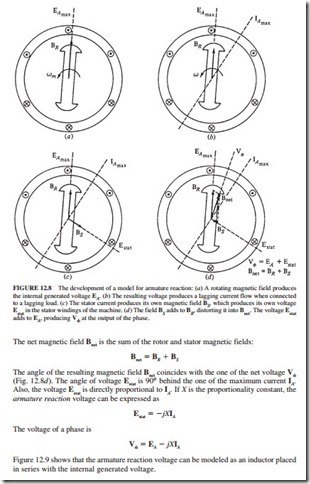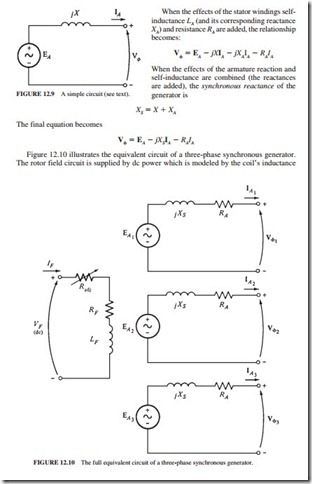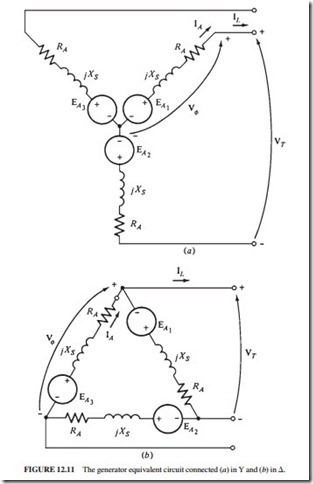THE EQUIVALENT CIRCUIT OF A SYNCHRONOUS GENERATOR
Voltage EA is the internal generated voltage induced in one phase of a synchronous generator. However, this is not the usual voltage that appears at the terminals of the generator. In reality, the internal voltage EA is the same as the output voltage Vcp of a phase only when there is no armature current flowing in the stator.
These factors cause the difference between EA and Vcp:
1. The armature reaction, which is the distortion of the air gap magnetic field by the current flowing in the stator
2. The self-inductance of the armature (stator) windings
3. The resistance of the armature windings
The armature reaction has the largest impact on the difference between EA and Vcp.
The voltage EA is induced when the rotor is spinning. If the generator’s terminals are attached to a load, a current flows.
The three-phase current flowing in the stator will produce its own magnetic field in the machine. This stator magnetic field distorts the magnetic field produced by the rotor, resulting in a change of the phase voltage. This effect is known as the armature reaction because the current in the armature (stator) affects the magnetic field which produced it in the first place.
Figure 12.8a illustrates a two-pole rotor spinning inside a three-phase stator when there is no load connected to the machine. An internal generated voltage EA is produced by the rotor magnetic field BR whose direction coincides with the peak value of EA. The voltage will be positive out of the top conductors and negative into the bottom conductors of the stator.
When the generator is not connected to a load, there is no current flow in the armature. The phase voltage Vcp will be equal to EA. When the generator is connected to a lagging load, the peak current will occur at an angle behind the peak voltage (Fig. 12.8b).
The current flowing in the stator windings produces a magnetic field called BS whose direction is given by the right-hand rule (Fig. 12.8c). A voltage is produced in the stator Estat by the stator magnetic field BS . The total voltage in a phase is the sum of the internal voltage EA and the armature reaction voltage Estat:
FIGURE 12.9 A simple circuit (see text).
The final equation becomes
When the effects of the stator windings self- inductance LA (and its corresponding reactance XA) and resistance RA are added, the relationship becomes:
and resistance in series. The adjustable resistance Radj controls the field current. The internal generated voltage for each of the phases is shown in series with the synchronous reactance XS and the stator winding resistance RA. The three phases are identical except that the voltages and currents are 120° apart in angle.
Figure 12.11 illustrates that the phases can be either Y- or 6.-connected. When they are Y-connected, the terminal voltage VT is related to the phase voltage Vcp by
Since the three phases are identical except that their phase angles are different, the per- phase equivalent circuit is used (Fig. 12.12).


